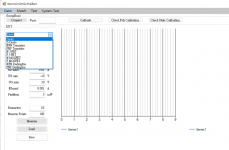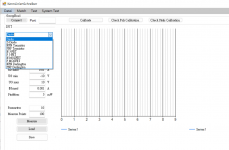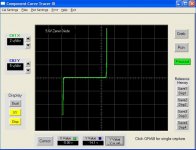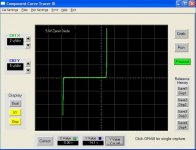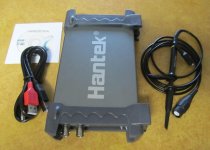This thread has been quiet for some time so allow me to add some info.
First of all, I too am looking for a powerful curve tracer. Gona build me some amps in the future and a curve tracer is a must. I am glad erikovsky made me look for the Locky_z 2019 Curve tracer / Intelligent Curve Tracer. A good friend of mine is using this one for all of his builds, and prior to me locating this tracer on ebay, I would be dependent on him to match my MOSFETs.
While going over this thread I noticed the lack of two curve tracer projects that I find of interest, so figured I would share them and get some inputs. Do note that both of this projects needs to have the PCB's produced since they are not available.
Both of these projects are presented via Elektor.
Tracer #1:
This practical instrument can be used to measure and record the characteristic curves of NPN and PNP bipolar transistors, N- and P-channel JFETs, and N- and P-channel MOSFETs. The circuit is based on an R8C/13 microcontroller, which transfers the measurement data to a Windows application program via USB.
This link include gerber and BOM files:
Transistor Curve Tracer | Elektor Magazine
This link include a description:
Transistor Curve Tracer (080068) | Elektor Magazine
I have attached the Elector article published 02/2009.
Tracer #2:
By Rainer Schuster - This tracer is newer and more powerful. Can do both tubes and semiconductor, BJT, NPN/PNP and FET.
This versatile equipment can either be used as a power supply for tube experiments, or as a curve tracer. Originally, it was planned as a tube curve tracer, but during development, the idea came up to extend the functionality to a semiconductor curve tracer especially for high voltage transistors/ Mosfets and Zenerdiodes. It is controlled by a Raspberry Pi (model 2 or 3) together with a 7” touch screen. Voltage and current can be controlled via virtual potentiometers on the touch screen.
Actual voltages and currents are displayed via “7 segment displays” also located on the touch screen. The graphical user interface was designed wit Qt designer (see also Software).
MOSFET; Uds max 400V and Id to 300mA.
Here is a Youtube link showing the operation: HV Power Supply - Rohren - und Halbleiter Kennlinienschreiber mit Raspberry Pi - YouTube
Here is the main project; HV Power supply with tube and semiconductor curve tracer | Elektor Magazine
First of all, I too am looking for a powerful curve tracer. Gona build me some amps in the future and a curve tracer is a must. I am glad erikovsky made me look for the Locky_z 2019 Curve tracer / Intelligent Curve Tracer. A good friend of mine is using this one for all of his builds, and prior to me locating this tracer on ebay, I would be dependent on him to match my MOSFETs.
While going over this thread I noticed the lack of two curve tracer projects that I find of interest, so figured I would share them and get some inputs. Do note that both of this projects needs to have the PCB's produced since they are not available.
Both of these projects are presented via Elektor.
Tracer #1:
This practical instrument can be used to measure and record the characteristic curves of NPN and PNP bipolar transistors, N- and P-channel JFETs, and N- and P-channel MOSFETs. The circuit is based on an R8C/13 microcontroller, which transfers the measurement data to a Windows application program via USB.
This link include gerber and BOM files:
Transistor Curve Tracer | Elektor Magazine
This link include a description:
Transistor Curve Tracer (080068) | Elektor Magazine
I have attached the Elector article published 02/2009.
Tracer #2:
By Rainer Schuster - This tracer is newer and more powerful. Can do both tubes and semiconductor, BJT, NPN/PNP and FET.
This versatile equipment can either be used as a power supply for tube experiments, or as a curve tracer. Originally, it was planned as a tube curve tracer, but during development, the idea came up to extend the functionality to a semiconductor curve tracer especially for high voltage transistors/ Mosfets and Zenerdiodes. It is controlled by a Raspberry Pi (model 2 or 3) together with a 7” touch screen. Voltage and current can be controlled via virtual potentiometers on the touch screen.
Actual voltages and currents are displayed via “7 segment displays” also located on the touch screen. The graphical user interface was designed wit Qt designer (see also Software).
MOSFET; Uds max 400V and Id to 300mA.
Here is a Youtube link showing the operation: HV Power Supply - Rohren - und Halbleiter Kennlinienschreiber mit Raspberry Pi - YouTube
Here is the main project; HV Power supply with tube and semiconductor curve tracer | Elektor Magazine
Attachments
Hi guys.
Has anyone tried programmable PSU's RD6006, RD6012 & RD6018? Are they compatible with the mbrennwa/PyPSUcurvetrace?
Has anyone tried programmable PSU's RD6006, RD6012 & RD6018? Are they compatible with the mbrennwa/PyPSUcurvetrace?
I have looked at these, too. They are on my to-do list. If someone has or Bugs one of these, I would be interested to borrow and write the code for them.Hi guys.
Has anyone tried programmable PSU's RD6006, RD6012 & RD6018? Are they compatible with the mbrennwa/PyPSUcurvetrace?
Hi guys.
Has anyone tried programmable PSU's RD6006, RD6012 & RD6018? Are they compatible with the mbrennwa/PyPSUcurvetrace?
Also courious about this, its a decent cheapo bench supply and if you can curve trace with it, Bob's your uncle as they say.I have looked at these, too. They are on my to-do list. If someone has or Bugs one of these, I would be interested to borrow and write the code for them.
You should be looking at P versions, upgraded with higher resolution readout and order of magnitude lower output ripple, but only like 20$ more, can find them easily on Ali. Since we would need two PSU's for the script, think its worth looking at "bargains" like this.
Somebody also made this curve tracer project with them, but its paywalled. Even after register you need elektor green or gold membership. https://www.elektormagazine.com/magazine/elektor-155/58962
@Oneminde do you think you could get us the article?
If someone would want to borrow one of these PSUs to me I could add support for them in PyPSUcuvetrace.Also courious about this, its a decent cheapo bench supply and if you can curve trace with it, Bob's your uncle as they say.
You should be looking at P versions, upgraded with higher resolution readout and order of magnitude lower output ripple, but only like 20$ more, can find them easily on Ali. Since we would need two PSU's for the script, think its worth looking at "bargains" like this.
View attachment 1053771
Somebody also made this curve tracer project with them, but its paywalled. Even after register you need elektor green or gold membership. https://www.elektormagazine.com/magazine/elektor-155/58962
@Oneminde do you think you could get us the article?
You would need two of them right? Or, maybe you can develop with only one, but two would be needed for curve tracing, right?If someone would want to borrow one of these PSUs to me I could add support for them in PyPSUcuvetrace.
Considering maybe building one and shipping it out to you.. (afaik, from back when flags were visible on forum, you're Swiss?)
To get it working with the software, one unit is enough.You would need two of them right? Or, maybe you can develop with only one, but two would be needed for curve tracing, right?
Considering maybe building one and shipping it out to you.. (afaik, from back when flags were visible on forum, you're Swiss?)
For curve tracing, two PSUs are needed. You may use two different PSUs.
Yes, I am in Switzerland.
@mbrennwa
It would be great if the PyPSU Curve Tracer can support Ruiden RD series.
I used to wanna trying PyPSU, and I though SCPI is a must. KORAD is fine but they are 220V mostly which is not my mains volt (110V).
Also, I know other 110V PSUs with SCPI, but without your test, I was afraid they are not PyPSU-Compatible, thus wasting 300~400USD.
Since RuiDen RD series is popular and compatible with 110V mains, If PyPSU is OK with them, I will greatly appreciate that, and I think that will make PyPSU
much more convinient for everyone.
PyPSU is really a good idea and is very potential, for either Tube or Semiconductor, PyPSU is for sure a very good solution of curve tracing.
It would be great if the PyPSU Curve Tracer can support Ruiden RD series.
I used to wanna trying PyPSU, and I though SCPI is a must. KORAD is fine but they are 220V mostly which is not my mains volt (110V).
Also, I know other 110V PSUs with SCPI, but without your test, I was afraid they are not PyPSU-Compatible, thus wasting 300~400USD.
Since RuiDen RD series is popular and compatible with 110V mains, If PyPSU is OK with them, I will greatly appreciate that, and I think that will make PyPSU
much more convinient for everyone.
PyPSU is really a good idea and is very potential, for either Tube or Semiconductor, PyPSU is for sure a very good solution of curve tracing.
PyPSUcurvetrace already has SCPI support, but the use of SCPI is different between PSU models. Therefore the code must be adapted to each PSU model (no matter if the PSU uses SCPI or not).
On Google: https://www.google.com/search?q=component+curve+tracerWhere can I find component curve tracer?
A DIY Component Curve Tracing system with DUT-matching function and plotting.
Not only can it make the I-V curve, but also auto-algorithm-based characteristic matching.
By this, people can easily manage transistors in the basis of batch,
and the system shows you the best-matched pairs and tells you the amount of mismatch, superb!
This is similar to another tracer I introduced earlier, so I love it a lot, another super helper for amateur DIYers!
I am happy with my iTracers on hand, but also glad to seem another project like this!
I will attach the source latter (of course), as I am surprised it seems no one here talked about this?
Anyone knows the origin of this project and author?










Not only can it make the I-V curve, but also auto-algorithm-based characteristic matching.
By this, people can easily manage transistors in the basis of batch,
and the system shows you the best-matched pairs and tells you the amount of mismatch, superb!
This is similar to another tracer I introduced earlier, so I love it a lot, another super helper for amateur DIYers!
I am happy with my iTracers on hand, but also glad to seem another project like this!
I will attach the source latter (of course), as I am surprised it seems no one here talked about this?
Anyone knows the origin of this project and author?
Attachments
dear friends, I need this program, where can I find it, which programmer do I need to use it with this program? can you see this link?
Curve Tracer III programer
link:https://circuitcellar.com/research-design-hub/create-your-own-i-v-curve-tracer/
thank you
Curve Tracer III programer
link:https://circuitcellar.com/research-design-hub/create-your-own-i-v-curve-tracer/
thank you
Attachments
I am building this in the moment: https://www.diyaudio.com/community/threads/diy-curve-tracer-analog.379436/post-7204586
And I have this: https://www.diyaudio.com/community/threads/is-there-interest-in-a-new-tubetester.384309/post-6987173
Which is a Raspi powered Curvetracer for tubes, BJT, Fets, Diodes…
An excellent device!
And I have this: https://www.diyaudio.com/community/threads/is-there-interest-in-a-new-tubetester.384309/post-6987173
Which is a Raspi powered Curvetracer for tubes, BJT, Fets, Diodes…
An excellent device!
Send you a PM…A DIY Component Curve Tracing system with DUT-matching function and plotting.
Not only can it make the I-V curve, but also auto-algorithm-based characteristic matching.
By this, people can easily manage transistors in the basis of batch,
and the system shows you the best-matched pairs and tells you the amount of mismatch, superb!
This is similar to another tracer I introduced earlier, so I love it a lot, another super helper for amateur DIYers!
I am happy with my iTracers on hand, but also glad to seem another project like this!
I will attach the source latter (of course), as I am surprised it seems no one here talked about this?
Anyone knows the origin of this project and author?
View attachment 1122017View attachment 1122012
View attachment 1122010View attachment 1122011View attachment 1122003View attachment 1122005View attachment 1122006View attachment 1122007View attachment 1122008View attachment 1122009
Yes, I have replied, please check you mail box.Send you a PM…
Thank you. 🙂
hello dear friends, where can I find the program in this picture that I want to learn, I want to use it with Hantek 6022BE with or without charge
thanks
link:https://circuitcellar.com/research-design-hub/create-your-own-i-v-curve-tracer/
thanks
link:https://circuitcellar.com/research-design-hub/create-your-own-i-v-curve-tracer/
Attachments
As promise before, the answer of the tracer I posted earlier is designed by Dr. Borgmann, "diy.ucborgmann.de/",
I found this project accidentally, and I soon realized this is a great design of curve tracer with additional matching algorithm.
For such a good tracer project, I think it should be well discussed here, therefore I introduced it earlier.
(Also, don't get me wrong, I never claim it my design, I just put it here for guessing the source so all tribute and credit to the author!)
There are other interesting project on the websites, worth reading them. Enjoy and pay all tribute to Dr. Borgmann!
Check it out here:
http://diy.ucborgmann.de/index.php/en/audio-messtechnik-2/characteristic-curve-recorder
Specs in brief:
Vg: +-12V
Ig: +-120mA
Vd: +-20V
Id: +-2A
Simply speaking, the tracer has the ability up to 20V/2A, with up to 16Bit ADC used.
This spec is great enough for amateur DIYers, satisfying most measurements of audio transistors, although probably not fully enough for output-stage power transistors.
Mechanism of Working Diagram:

Amazingly, the DAC could be upgrade from 12bits to 16bits! (With LTC1655 module, and independent Vref=2.5V)

The available sources are below, including schematic, GERBER, BOM, MCU FW and Windows software.

Assembled tracer looks like this:

NOTICE:
I noticed there are fly-wires of the PCB, I am not sure if it is corrected in the GERBER file, so make decision and take the risk by self.
I am not responsible if resources available from the Website which may or may not be correct, accurate and complete.
Any replication and usage of the resources from the Website is at your own risk, as also state above.
All credits belong to the website's author.
I found this project accidentally, and I soon realized this is a great design of curve tracer with additional matching algorithm.
For such a good tracer project, I think it should be well discussed here, therefore I introduced it earlier.
(Also, don't get me wrong, I never claim it my design, I just put it here for guessing the source so all tribute and credit to the author!)
There are other interesting project on the websites, worth reading them. Enjoy and pay all tribute to Dr. Borgmann!
Check it out here:
http://diy.ucborgmann.de/index.php/en/audio-messtechnik-2/characteristic-curve-recorder
Specs in brief:
Vg: +-12V
Ig: +-120mA
Vd: +-20V
Id: +-2A
Simply speaking, the tracer has the ability up to 20V/2A, with up to 16Bit ADC used.
This spec is great enough for amateur DIYers, satisfying most measurements of audio transistors, although probably not fully enough for output-stage power transistors.
Mechanism of Working Diagram:
Amazingly, the DAC could be upgrade from 12bits to 16bits! (With LTC1655 module, and independent Vref=2.5V)
The available sources are below, including schematic, GERBER, BOM, MCU FW and Windows software.
Assembled tracer looks like this:
NOTICE:
I noticed there are fly-wires of the PCB, I am not sure if it is corrected in the GERBER file, so make decision and take the risk by self.
I am not responsible if resources available from the Website which may or may not be correct, accurate and complete.
Any replication and usage of the resources from the Website is at your own risk, as also state above.
All credits belong to the website's author.
Has anyone tried programmable PSU's RD6006, RD6012 & RD6018? Are they compatible with the mbrennwa/PyPSUcurvetrace?
Also courious about this, its a decent cheapo bench supply and if you can curve trace with it, Bob's your uncle as they say.
You should be looking at P versions, upgraded with higher resolution readout and order of magnitude lower output ripple, but only like 20$ more, can find them easily on Ali. Since we would need two PSU's for the script, think its worth looking at "bargains" like this.
It would be great if the PyPSU Curve Tracer can support Ruiden RD series.
PyPSUcurvetrace now has preliminary/experimental support the Riden/Ruiden RD power supplies, see here.
- Home
- Amplifiers
- Pass Labs
- DIY Curve Tracer for Mosfet Matching

